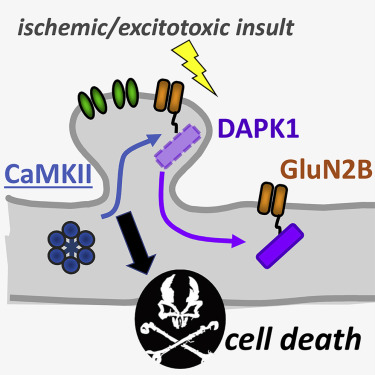Our official English website, www.x-mol.net, welcomes your
feedback! (Note: you will need to create a separate account there.)
CaMKII versus DAPK1 Binding to GluN2B in Ischemic Neuronal Cell Death after Resuscitation from Cardiac Arrest.
Cell Reports ( IF 7.5 ) Pub Date : 2020-01-07 , DOI: 10.1016/j.celrep.2019.11.076 Olivia R Buonarati 1 , Sarah G Cook 1 , Dayton J Goodell 2 , Nicholas E Chalmers 3 , Nicole L Rumian 2 , Jonathan E Tullis 1 , Susana Restrepo 1 , Steven J Coultrap 1 , Nidia Quillinan 4 , Paco S Herson 5 , K Ulrich Bayer 2
Cell Reports ( IF 7.5 ) Pub Date : 2020-01-07 , DOI: 10.1016/j.celrep.2019.11.076 Olivia R Buonarati 1 , Sarah G Cook 1 , Dayton J Goodell 2 , Nicholas E Chalmers 3 , Nicole L Rumian 2 , Jonathan E Tullis 1 , Susana Restrepo 1 , Steven J Coultrap 1 , Nidia Quillinan 4 , Paco S Herson 5 , K Ulrich Bayer 2
Affiliation

|
DAPK1 binding to GluN2B was prominently reported to mediate ischemic cell death in vivo. DAPK1 and CaMKII bind to the same GluN2B region, and their binding is mutually exclusive. Here, we show that mutating the binding region on GluN2B (L1298A/R1300Q) protected against neuronal cell death induced by cardiac arrest followed by resuscitation. Importantly, the GluN2B mutation selectively abolished only CaMKII, but not DAPK1, binding. During ischemic or excitotoxic insults, CaMKII further accumulated at excitatory synapses, and this accumulation was mediated by GluN2B binding. Interestingly, extra-synaptic GluN2B decreased after ischemia, but its relative association with DAPK1 increased. Thus, ischemic neuronal death requires CaMKII binding to synaptic GluN2B, whereas any potential role for DAPK1 binding is restricted to a different, likely extra-synaptic population of GluN2B.
中文翻译:

在心脏骤停复苏后,缺血性神经元细胞死亡中CaMKII与DAPK1与GluN2B的结合。
据报道,DAPK1与GluN2B的结合可介导体内缺血性细胞死亡。DAPK1和CaMKII结合到相同的GluN2B区,并且它们的结合是互斥的。在这里,我们表明突变GluN2B(L1298A / R1300Q)上的结合区域受到保护,可防止因心脏骤停后复苏引起的神经元细胞死亡。重要的是,GluN2B突变仅选择性地消除了CaMKII的结合,而不是DAPK1的结合。在缺血性或兴奋性毒性损伤中,CaMKII在兴奋性突触中进一步积聚,并且该积聚由GluN2B结合介导。有趣的是,突触后GluN2B在缺血后减少,但与DAPK1的相对联系增加。因此,缺血性神经元死亡需要CaMKII与突触GluN2B结合,而DAPK1结合的任何潜在作用仅限于不同的,
更新日期:2020-01-07
中文翻译:

在心脏骤停复苏后,缺血性神经元细胞死亡中CaMKII与DAPK1与GluN2B的结合。
据报道,DAPK1与GluN2B的结合可介导体内缺血性细胞死亡。DAPK1和CaMKII结合到相同的GluN2B区,并且它们的结合是互斥的。在这里,我们表明突变GluN2B(L1298A / R1300Q)上的结合区域受到保护,可防止因心脏骤停后复苏引起的神经元细胞死亡。重要的是,GluN2B突变仅选择性地消除了CaMKII的结合,而不是DAPK1的结合。在缺血性或兴奋性毒性损伤中,CaMKII在兴奋性突触中进一步积聚,并且该积聚由GluN2B结合介导。有趣的是,突触后GluN2B在缺血后减少,但与DAPK1的相对联系增加。因此,缺血性神经元死亡需要CaMKII与突触GluN2B结合,而DAPK1结合的任何潜在作用仅限于不同的,











































 京公网安备 11010802027423号
京公网安备 11010802027423号